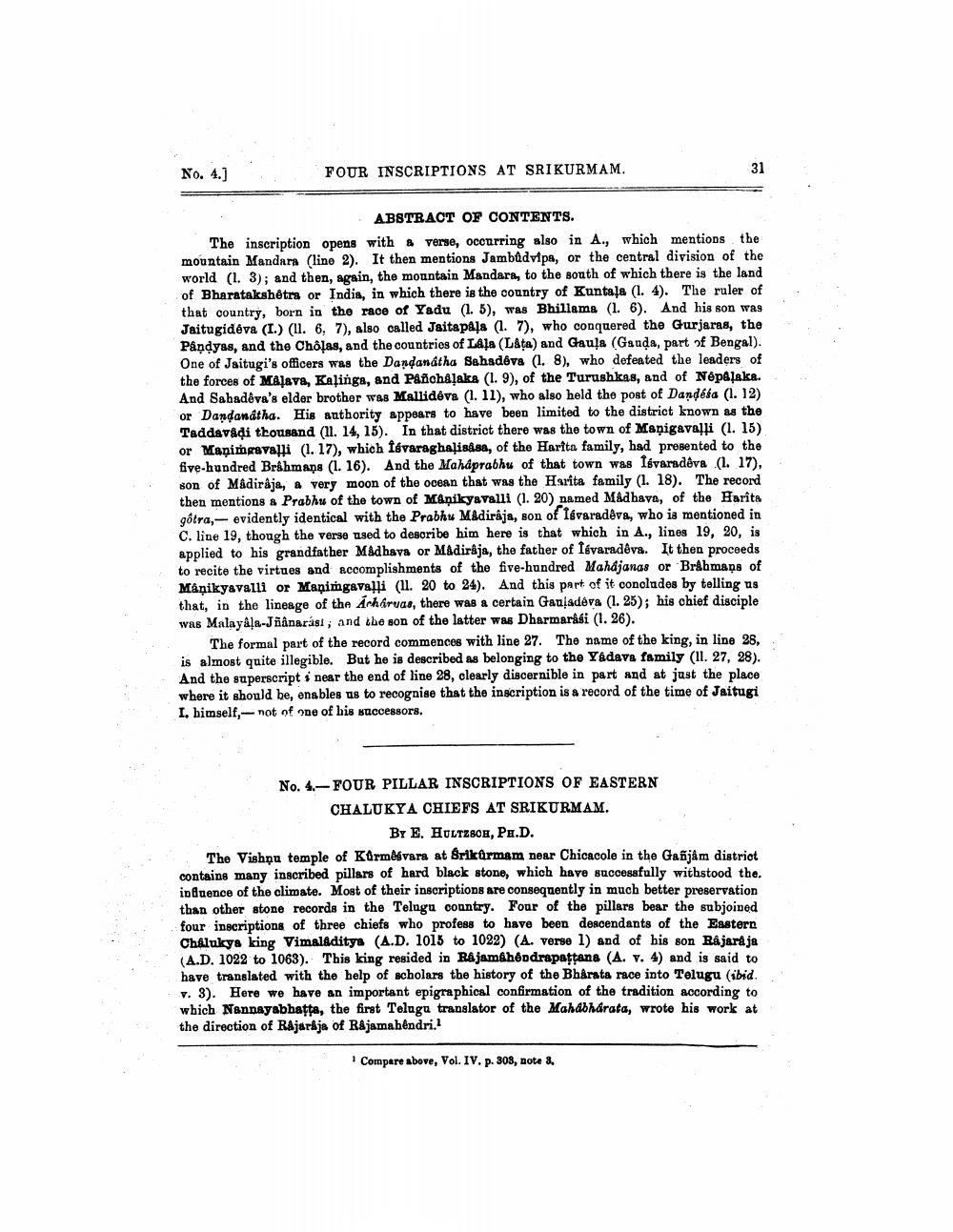________________
No. 4.]
FOUR INSCRIPTIONS AT SRIKURMAM.
ABSTRACT OF CONTENTS. The inscription opens with a verse, occurring also in A., which mentions the mountain Mandara (lino 2). It then mentions Jambūdvipa, or the central division of the world (1. 3); and then, again, the mountain Mandara, to the south of which there is the land of Bharatakshetra or India, in which there is the country of Kuntala (1.4). The ruler of that country, born in the race of Yadu (1. 5), was Bhillame (1.6). And his son was Jaitugidêva (I.) (11. 6, 7), also called Jaitapals (1.7), who conquered the Gurjaras, the Påndyas, and the Chôļas, and the countries of Lala (L&ta) and Gaula (Gauda, part of Bengal). One of Jaitugi's officers was the Dandanátha Sahadeva (1. 8), who defeated the leaders of the forces of Malaya, Kalinga, and Pafchalaka (1. 9), of the Turushkas, and of Népalaka. And Sahadeva's elder brother was Mallidéva (1. 11), who also held the post of Dandeta (1.12) or Dandanatha. His authority appears to have been limited to the district known as the Taddavadi thousand (11. 14, 15). In that district there was the town of Maņigavalli (1. 15) or Manimgavalli (1.17), which isvaraghaļisasa, of the Harita family, had presented to the five-hundred Brahmans (1. 16). And the Maháprabhu of that town was Isvaradeva (1.17), son of Mâdirâja, a very moon of the ocean that was the Harita family (1. 18). The record then mentions & Prabhu of the town of Manikyavalli (I. 20) named Madhava, of the Harita gôtra, evidently identical with the Prabhu Madiraja, son of Isvaradeva, who is mentioned in C. line 19, though the verse used to describe him here is that which in A., lines 19, 20, is applied to his grandfather Madhava or Madiraja, the father of Isvaradeva. It then proceeds to recite the virtues and accomplishments of the five-hundred Mahájanas or Brahmans of Manikyavalli or Manimgavalli (11. 20 to 24). And this part of it concludes by telling us that, in the lineage of the Acharvas, there was a certain Gauladeva (1.25); his chief disciple was Malayala-J ñånarást, and the son of the latter was Dharmarasi (1.26).
The formal part of the record commences with line 27. The name of the king, in line 28, is almost quite illegible. But he is described as belonging to the Yadava family (II. 27, 28). And the superscript i near the end of line 28, clearly discernible in part and at just the place where it should be enables us to recognise that the inscription is a record of the time of Jaitugi I himself, - not of one of his successors.
No. 4.-FOUR PILLAR INSCRIPTIONS OF EASTERN CHALUKYA CHIEFS AT SRIKURMAM.
BY E. HULTZBOH, PH.D. The Vishnu temple of Kirmdivara at Srikurmam near Chicacole in the Gafjám district contains many inscribed pillars of hard black stone, which have successfully withstood the. influence of the climate. Most of their inscriptions are consequently in much better preservation than other stone records in the Teluga country. Four of the pillars bear the subjoined four inscriptions of three chiefs who profess to have been descendants of the Eastern Chalukya king VimalAditya (A.D. 1015 to 1022) (A. verse 1) and of his son Rajaraja (A.D. 1022 to 1063). This king resided in Rajamahopdrapattana (A. v. 4) and is said to have translated with the help of scholars the history of the Bharata race into Telugu (ibid. v. 3). Here we have an important epigraphical confirmation of the tradition according to which Nannayabhatta, the first Telugu translator of the Mahabharata, wrote his work at the direction of Rajaraja of R&jamahendri.
Compare above, Vol. IV. p. 308, note 8.




